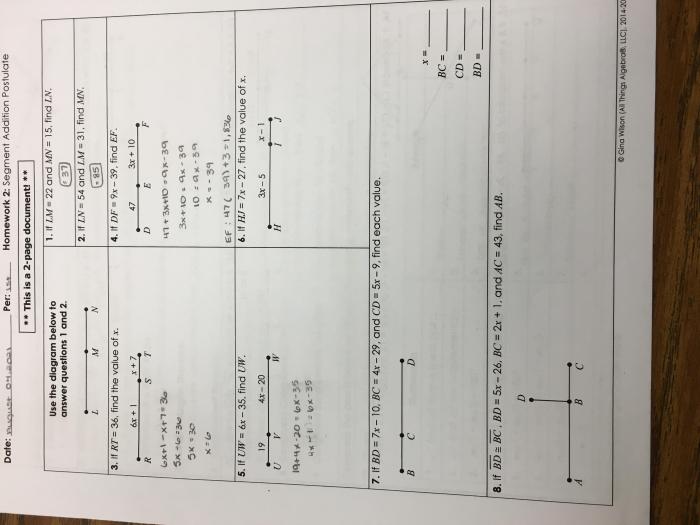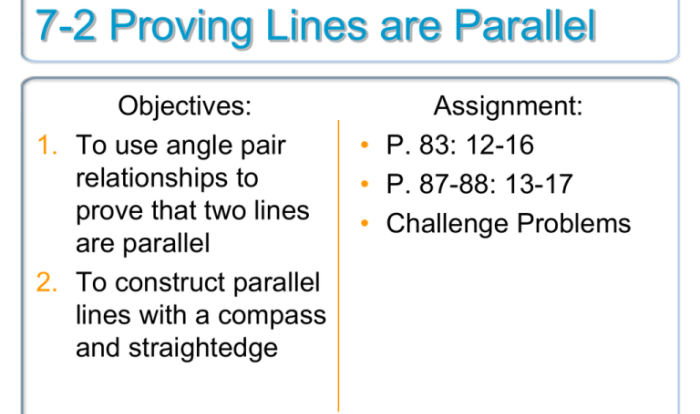Embarking on a journey through unit 1 homework 5 angle relationships, we delve into the fascinating realm of geometry, where angles play a pivotal role in shaping our understanding of shapes and their properties. This exploration promises to illuminate the intricacies of supplementary and complementary angles, empowering us to identify and classify various angle pairs with precision.
Beyond the theoretical foundations, we will venture into the practical aspects of angle measurement and construction, mastering the art of utilizing protractors and compasses to determine and create angles with accuracy. The relationship between angles in triangles and polygons will also be brought to light, unraveling the secrets behind their interior and exterior angles.
Angle Relationships in Unit 1 Homework 5

Unit 1 Homework 5 delves into the fascinating world of angle relationships, exploring various concepts and applications. This article aims to provide a comprehensive overview of the key topics covered in this homework assignment.
Supplementary Angles
Supplementary angles are two angles whose sum is 180 degrees. They are often found in pairs on opposite sides of a straight line. Examples of supplementary angles include:
- Two 90-degree angles
- A 60-degree angle and a 120-degree angle
Complementary Angles
Complementary angles are two angles whose sum is 90 degrees. They are often used to form right angles. Properties of complementary angles include:
- They are adjacent, meaning they share a common vertex and a common side.
- Their sum is always 90 degrees.
- They can be used to form a right triangle.
Types of Angle Pairs
Based on their relationship, angle pairs can be classified into several types:
- Adjacent Angles:Angles that share a common vertex and a common side.
- Vertical Angles:Angles that are opposite each other when two lines intersect.
- Linear Pair:Two adjacent angles that form a straight line, with a sum of 180 degrees.
Measuring and Constructing Angles, Unit 1 homework 5 angle relationships
Measuring and constructing angles accurately is crucial in geometry. Common tools used include protractors and compasses.
Measuring Angles:A protractor is a tool used to measure the size of angles. It is placed over the vertex of the angle, and the angle’s measure is read off the scale.
Constructing Angles:To construct an angle using a protractor, follow these steps:
- Draw a ray from the vertex.
- Align the protractor’s center with the vertex and the zero mark with the ray.
- Mark the desired angle measure on the protractor’s scale.
- Draw a ray from the vertex through the mark to form the second side of the angle.
Bisecting an Angle:To bisect an angle using a compass and straightedge, follow these steps:
- Draw an arc from the vertex that intersects both sides of the angle.
- Repeat step 1 from the other side of the angle.
- Draw a line connecting the two points of intersection. This line bisects the angle.
Angle Relationships in Triangles
Triangles are polygons with three sides and three angles. The interior angles of a triangle have special relationships:
- Sum of Interior Angles:The sum of the interior angles of a triangle is always 180 degrees.
- Exterior Angle Theorem:The measure of an exterior angle of a triangle is equal to the sum of the measures of the two non-adjacent interior angles.
Based on their angle measures, triangles can be classified as:
- Acute Triangle:All three interior angles are less than 90 degrees.
- Right Triangle:One interior angle is 90 degrees.
- Obtuse Triangle:One interior angle is greater than 90 degrees.
Angle Relationships in Polygons
Polygons are closed figures with three or more sides. The interior and exterior angles of polygons have specific relationships:
- Sum of Interior Angles:The sum of the interior angles of a polygon with n sides is given by (n-2) x 180 degrees.
- Exterior Angle Sum:The sum of the exterior angles of a polygon is always 360 degrees.
Regular polygons are polygons with equal sides and equal angles. To construct a regular polygon, you can use the following formula:
Interior Angle Measure:180 – (360/n) degrees, where n is the number of sides.
FAQ Explained: Unit 1 Homework 5 Angle Relationships
What are supplementary angles?
Supplementary angles are two angles whose sum is 180 degrees.
How do I construct an angle using a protractor?
Place the center of the protractor on the vertex of the angle and align the 0-degree mark with one side of the angle. Mark the desired angle measure on the other side of the angle.
What is the exterior angle theorem?
The exterior angle theorem states that the measure of an exterior angle of a triangle is equal to the sum of the measures of the two opposite interior angles.


